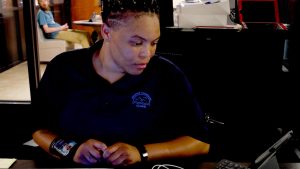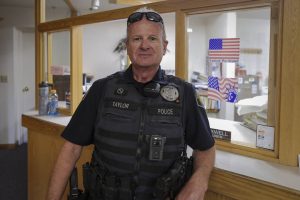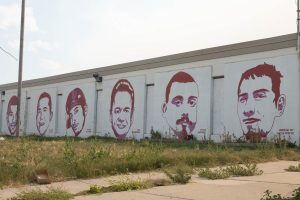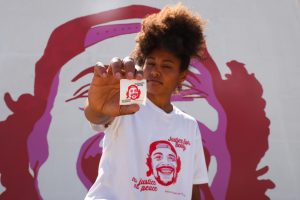- Slug: BC-CNS News21 Mental Health Reforms, 3,510 words.
- 1 video here.
- 10 photos and captions below.
By Chin Tung Tan
News21
SALT LAKE CITY – Rae Duckworth rummaged through her fanny pack and produced a sticker showing a portrait of a man painted with bright pink and red ink.
The man smiles brightly, eyes crinkling. On the bottom of the sticker, it says “No justice. No peace” and “#DUCKWORTHSTRONG.”
Utah residents may recognize the man as one of the many faces painted on the murals in downtown Salt Lake City to memorialize victims of police brutality.
His name is Bobby Duckworth. Rae Duckworth, Bobby’s cousin and leader of Black Lives Matter Utah, passes these stickers out to everyone she meets, hoping one day she will see her cousin’s face everywhere.
Police Officer Garrett Safley shot and killed Bobby Duckworth in rural Wellington, southeast of Salt Lake City, in September 2019. Duckworth’s fiance told local reporters the 26-year-old was having a mental health crisis.
After a round of investigations, prosecutors determined that Safley’s action was lawful.
“I truly believe Bobby needed a hug and not bullets,” Rae Duckworth said, holding back tears. “The whole system failed him. He didn’t have any support.”
She joins protesters every other Thursday at Washington Square Park outside Salt Lake City’s mayor’s office to protest the decision to pull out of meetings of the Community Activists Group. Duckworth also has spent hours at the state Capitol to speak on various police reform bills, including those addressing the response to mental health calls.
“Police reform is overdue,” she said. “I will always speak up for bills that support the community.”
In February, Duckworth spoke to the Legislature to support a bill that would allocate funds for what’s known as co-response, which pairs social workers with police officers on mental health crisis calls. The model has grown in popularity across the country as police departments grapple with how to respond to a growing number of calls involving people in mental health crises.
A 2020 analysis by the Center for American Progress of 911 calls from eight cities found that 21% to 38% involved homelessness, behavioral health crises, substance use, quality-of-life concerns and other community conflicts.
“Police are the de facto mental health providers in our community because we have historically underinvested in mental health,” said Zack Stoycoff, the executive director of Healthy Minds Policy Initiative, an Oklahoma nonprofit developing statewide data-informed policies on mental illness and substance abuse.
But “police know they don’t have the training to handle mental health conditions,” Stoycoff said.
The public knows that, too, and now it’s demanding change in both the criminal justice and mental health system. Fifty-eight percent of the 1,352 respondents to a 2020 survey created by Data for Progress said they support the creation of a nonpolice first-responder agency to handle issues that don’t require police presence.
Every state, county and city across the country must figure out what works for them. Most strategies focus on such trends as shifting funds away from police toward social services, creating diversion programs to triage low-level 911 calls and training officers on how to better respond.
There’s no simple set of solutions to this nationwide problem. Experts, advocates and the public say the answer must rely on a combination of efforts: reduce or eliminate law enforcement’s role in behavioral health crisis response, train and equip law enforcement officers when they do need to respond, and improve treatment for psychiatric care.
But these approaches take time and money, political and community support and collaboration between agencies.
Amy Watson, a nationally recognized expert on mental health crisis response, has spent two decades examining police encounters with people with mental illnesses.
“There’s been various efforts at police reform that have really sort of chipped away at edges but not necessarily made significant, lasting change,” said Watson, a social work professor at the University of Wisconsin-Milwaukee. “To make that bigger change, we need to be at a point where we look at those other systems that we want to play a bigger role so that we can shift some things away from police and really redesign the law enforcement role.”
Defining the problem
When he became a law enforcement officer 33 years ago, Capt. Kevin Ickleberry of the Bartlesville Police Department in Oklahoma didn’t didn’t imagine he’d answer mental-crisis calls every day.
“If you’re not involved with somebody that has mental health crises, you don’t really understand either how well the system works or how poor it works,” he said.
Bartlesville police recently launched a pilot program to pair officers with social workers.
“The last thing we want to do is handcuff somebody and stick them in the back of a police car or behind the cage,” Ickleberry said. “We want everybody to be safe. We want everybody to have a better life, and part of that is trying to get them the best services we can.”
But the mere presence of police cars and uniformed officers can exacerbate feelings of distress in those experiencing a mental health crisis. Watson said police presence further stigmatizes mental health and defines these situations as dangerous and criminal.
“If someone feels really triggered, their behavior may be such that the officer thinks it’s resistant, and it sort of builds to a really awful situation for people,” Watson said. “Instead of having someone who’s there to help me, there’s basically somebody (there) to protect others from me and potentially arrest me.”
A 2018 Department of Justice survey of nearly 770 training academies across the country found that new recruits receive an average of 14 hours of mental health response training, compared with 68 hours of firearms training.
With little understanding of mental health crisis response, police officers can react with force. As of Sept. 10, according to the Washington Post’s database of fatal shootings by police, 1,640 of the 7,729 people killed by the police since 2015 were experiencing a behavioral health crisis.
Sara Foreman, a certified peer recovery support specialist who works for a mental health center in Pryor, Oklahoma, said these kinds of incidents are shown on the news all the time.
“Instead of de-escalating the situation, they (officers) either get scared or overwhelmed,” Foreman said. “They pull their gun out and shoot.”
Diverting mental health calls
The murder of George Floyd by Minneapolis police in May 2020 enraged millions and amplified Black Lives Matters protests around the world. “Defund the police” became the rallying cry for efforts to reallocate funds from law enforcement agencies to public health organizations and other social services.
Although few police departments have fully “defunded,” the movement to intercept behavioral crisis calls before they reach police has grown, specifically with crisis lines and mobile teams.
With crisis lines, trained call takers provide emotional support for people in crisis as an alternative to calling the police. Ideally, call takers can make referrals, dispatch mobile crisis teams and follow up with callers.
One of the most notable crisis lines is the 10-digit National Suicide Prevention Lifeline, which was recently replaced by the three-digit number 988.
“By calling 988,” Stoycoff said, “you really bypass, in most situations, the need for police to even come out, which is good.”
Since it launched July 16, this 24-hour hotline has faced concerns about underfunding and understaffing because it’s managed by more than 180 call centers nationwide, according to The New York Times. Some advocates and researchers warned the public against calling the number because of its ties with the police and the possibility of being involuntarily hospitalized.
The origin of the 988 Suicide & Crisis Lifeline can be traced to Utah state Sen. Daniel Thatcher, who worked to implement the idea in his state. Eventually, more than 20 community hotlines were consolidated into a statewide system.
In fiscal 2021, Utah’s crisis line received 92,532 calls, according to the Huntsman Mental Health Institute. Eighty-six percent of the crisis calls were resolved over the phone, and a mobile crisis outreach team was dispatched for 8%. Law enforcement had to intervene 2% of the time.
Thatcher predicted use of the national crisis line will spike – and he worries it could be overwhelmed.
“The entire system, I think, is going to work really well,” he said. “The only worry that I have is what happens if there are not enough people to answer the phones? That’s what’s keeping me up at night because you only get one chance to make a first impression.”
As the crisis lines continue to grow, so might the use of mobile crisis teams.
Licensed therapists or clinicians, certified peer recovery support specialists or case managers typically make up the 24/7 response teams, which provide immediate crisis stabilization services and connect people to long-term mental health resources.
“It is absolutely the best practice that mobile crisis responders respond instead of police in most situations, except where scene safety is needed,” Stoycoff said. “We have to figure out when it’s appropriate to have a police presence. And how do you do that? You do that through relationships and trust and collaboration and shared understanding of the roles of each of these people.”
Mobile crisis teams aren’t necessarily a new idea. The White Bird Clinic in Eugene, Oregon, has operated CAHOOTS, the Crisis Assistance Helping Out on the Streets, for 33 years. It has been widely used as a model throughout the U.S.
A recent Stanford University study indicated mobile crisis teams have the potential to reduce police involvement and save money. In Denver, the Support Team Assisted Response team helped law enforcement agencies avoid almost 1,380 “criminal offenses” within six months of the pilot program’s operation. That came with significant savings, the study said it could have cost four times as much if the police would have responded.
“It’s really appealing because it just makes so much more sense to get the right people there and to have a response that’s not frightening for people,” Watson said.
Some states have expanded the use of mobile crisis teams.
The Utah Legislature passed a bill to fund more crisis receiving centers and mobile crisis team expansion in rural areas. Utah ranks last in the nation for adult mental health care access because of provider shortages – and Utah’s rural communities face significant challenges, according to Mental Health America’s 2021 report.
In Ephraim, a town of about 5,700 people in central Utah, the Central Utah Counseling Center provides mental health services to six rural counties that cover 17,000 square miles.
A year since its inception, the mobile crisis outreach team has responded to 584 calls, many of which involved individuals with suicidal ideation or the intention to harm themselves.
“It’s well worth the money spent,” said Anna LaDamus, the center’s director of crisis services. “It’s well worth the time invested. It’s worth all of the growing pains.”
Allan Taylor runs the four-person police force in Salina, about 34 miles south of Ephraim. Before the crisis teams became an option in central Utah, he and his officers relied on their own de-escalation skills.
“It’s really important for our team to not escalate things,” he said. “I don’t care if it takes all night to negotiate with somebody or talk with somebody. I’d rather do that than the other alternatives.”
But now, his officers can call for help from mental health professionals.
Providing tools and resources
Experts agree that police shouldn’t respond to most behavioral health calls. But when they do, they should have the training and tools to deal with the situation. Police departments across the country have spent millions of dollars and uncounted hours training officers in crisis intervention.
One of the most popular models is the crisis intervention team, or CIT. The National Alliance on Mental Illness said there are more than 2,700 CIT programs in the U.S.
Ron Bruno, executive director for CIT International, said the model isn’t just about training but involves bringing together behavioral health services, law enforcement agencies, advocates, people with lived experiences and other resources to develop a plan that works.
That plan should include developing a crisis response system that is the most compassionate, most effective and least intrusive to the lives of people with mental health disorders, Bruno said.
This summer, the Arizona health-care system Mercy Care brought together several law enforcement agencies for a CIT training event in Tempe. They spent 40 hours in the span of five days learning about de-escalation tactics and practicing them. They heard from people with lived experiences, and the training included sessions entitled “family perspective,” “veteran perspective” and “hallucinations and hearing voices.”
Although many departments have signed on to CIT programs, Bruno said, only a small number are certified. CIT International in 2021 established a certification process to ensure departments are following best practices. As of September, only 15 programs were certified.
Bruno said many law enforcement agencies have misused CIT programs.
“There were so many people that claimed that they were doing CIT,” he said, “but then we’d get these calls from the community saying, ‘See, it doesn’t work. Our CIT officers just shot an unarmed person.’”
Bruno said most departments try to get all their officers CIT-trained when they should select a few vetted patrol officers.
“Not every officer has the skill set to handle everything perfectly, and we need to start realizing that,” Bruno said. “It has to be somebody that has the desire to work with this special population.”
Ickleberry, the police captain from Oklahoma, was involved with CIT 20 years ago as a crisis negotiator. He said he learned the importance of using the right tone when speaking to a person in crisis.
“A lot of times when law enforcement shows up, it’s the uniform that’s the threat, so we need to figure out a way to take that threat away,” he said. “The biggest way to do that is being able to talk to people.”
Other training may involve cultural competency.
Melissa Pitts Johnson, a health care professional in Pryor, Oklahoma, said that’s an important element in crisis response. As a citizen of the Cherokee Nation, she said there are certain cultural traditions and practices that may get misconstrued as symptoms of a mental health disorder.
“Sometimes that means we ask for help and education from the people that we’re serving because there’s no better expert in that,” she said.
In addition to training, some communities have found tools that have helped improve communication between law enforcement and health care professionals.
In northeast Oklahoma, that came in the form of iPads.
“Our iPad program is a level of care that literally puts treatment on demand in your hand,” said Johnson, the regional clinical director for GRAND Mental Health. “It has the ability to receive outpatient care from your team regardless of your location and to be able to get crisis support and 24/7 care literally at the touch of a button.”
GRAND Mental Health, which serves 12 counties and has headquarters in Claremore, has distributed more than 10,200 iPads in about six years with a total cost of about $4.8 million. They have distributed about 8,500 of them to clients and nearly 1,700 to first responders and hospital personnel.
The state reimburses the company for all crisis services – including the iPads – provided to Medicaid beneficiaries.
Nicholas Allgood, chief clinical officer of crisis services, said the iPads are especially effective in rural areas because they can provide immediate service.
“You’re not traveling anywhere,” Allgood said. “You’re not using gas. You’re not dependent on the client’s income. Your no-show rates go down for your sessions because they’re right there.”
Ickleberry said all Bartlesville patrol officers have iPads, and they’ve been a great tool. The department usually handles three to four calls a day with the help of the iPad, he said.
Officers can connect people with help with the click of a button. And most of the time, it doesn’t require the officer to transport somebody to a hospital and spend long hours waiting as they receive treatment.
Reducing the role of law enforcement
Foreman sits in the GRAND Mental Health Crisis Center in Pryor, Oklahoma, with her laptop on a table and an iPad propped next to her.
The iPad rang, and Foreman’s face brightened when she saw the name on the screen. The caller was a regular who she dubbed one of her “special ones.” It did not matter why the person called, she would listen to every word they had to say. As a peer support specialist, her job is to relate to the clients and restore hope in them.
“I see miracles every day working at this job,” Foreman said.
GRAND Mental Health’s service area covers 10,000 square miles, so instead of having one central crisis center, it has 22 locations that serve as an alternative for emergency rooms and jails.
Foreman said has seen people end up behind bars because officers don’t know how to handle a mental health crisis.
“Just sending that person to prison is not going to help the situation,” she said. “They need to be stabilized and medicated.”
In 2016, 56% of the U.S. prison population indicated a recent or previous mental health disorder, according to the Prison Policy Initiative.
For a comprehensive system to work, it needs three parts: a crisis call center to help get the right help to people, a crisis mobile team to respond when necessary and crisis receiving and stabilization facilities, according to the Substance Abuse and Mental Health Services Administration’s best practice guide.
GRAND Mental Health serves as a crisis receiving and stabilization facility. It has reduced inpatient psychiatric hospitalizations from 841 adult clients in 2015 to one in 2019 with the help of iPads and crisis receiving centers, according to a study by the National Association of State Mental Health Program Directors Research Institute.
The study also reports that the GRAND Model has produced an estimated $62 million in cost savings by diverting clients from inpatient hospitalization. As for the law enforcement side, the model has saved these agencies a total of 13,831, or 576 days, in time previously spent transporting people to a psychiatric hospital.
An Oklahoma law requires third parties to transport a person in crisis to the nearest treatment facility if the distance is greater than 30 miles. Previously, that responsibility fell on the shoulders of law enforcement agencies.
“In the old days when we transported people, we were transporting two to three people per day to mental health facilities,” Ickleberry said. “Since the iPad came along and then since the law changed in Oklahoma, GRAND Mental Health is the one that now transports them to their facilities, so that’s taking the load off us.”
What’s next?
To make any crisis response reform work, it requires funding, support and collaboration from all the key players – policymakers, law enforcement agencies, health care leaders and the public.
Stoycoff said a successful response involves everyone.
“It’s not up to one sector,” he said. “It’s not up to the mental health treatment system alone. You need to have a community that is responsive and able to provide pathways to treatment where and when they’re needed because it allows that treatment to occur sooner before it escalates to a crisis.”
State lawmakers have taken the launch of 988 as an opportunity to introduce legislation to strengthen and expand care. For example, in 2021, Virginia created a Crisis Contact Centers Fund to develop a comprehensive crisis system involving contact centers, mobile crisis teams and crisis stabilization centers. Similarly, Washington state appropriated $23 million to fund the operations of crisis contact centers, whose staff has the ability to deploy mobile crisis teams.
The same goes for Utah, where legislators supported funding to increase access to mental health crisis services in rural areas.
Utah state Rep. Steve Eliason has introduced more than 30 mental health-related bills since 2011.
The Republican legislator said his child was hospitalized a few years ago and needed to see a child psychiatrist. They eventually found one, but not before going through the emergency room. His experience showed him the need for improvement in the mental health system.
One of the bills he sponsored in 2021 involved requiring police officers to go through mandatory training to learn how to better interact with people on the autism spectrum and other mental illnesses. The governor signed it into law later that session.
“Our support has been very strong, very broad, very bipartisan,” he said. “It’s an area of police reform that I think everybody can agree with.”
Even with legislative support and funding, building a new system takes time.
Rachel Lucynski, director of crisis services at the Huntsman Mental Health Institute, said the creation of an integrated crisis response system in Utah represented more than a decade of partnerships with elected officials, commission members and state departments.
But for some, the pace of change is too slow.
Rae Duckworth, the activist in Salt Lake City, said she hopes the day will come when police don’t need to respond to mental health calls at all.
The younger generation gives her hope.
“The kids are way smarter, and if we’re not listening to them, we’re in trouble,” she said. “I don’t want them marching for stuff we could literally figure out. We can figure this out. We just got to all sit down and talk about it.”
“If we’re all participating, and we’re all realizing that the power is actually in our pockets, then we’re going to be unstoppable.”
News21 reporter Laura Bargfeld contributed to this article. This report is part of “In Pursuit,” an investigation into police reform and accountability in America, produced by the Carnegie-Knight News21 program. For more stories, visit inpursuit.news21.com.
^__=









